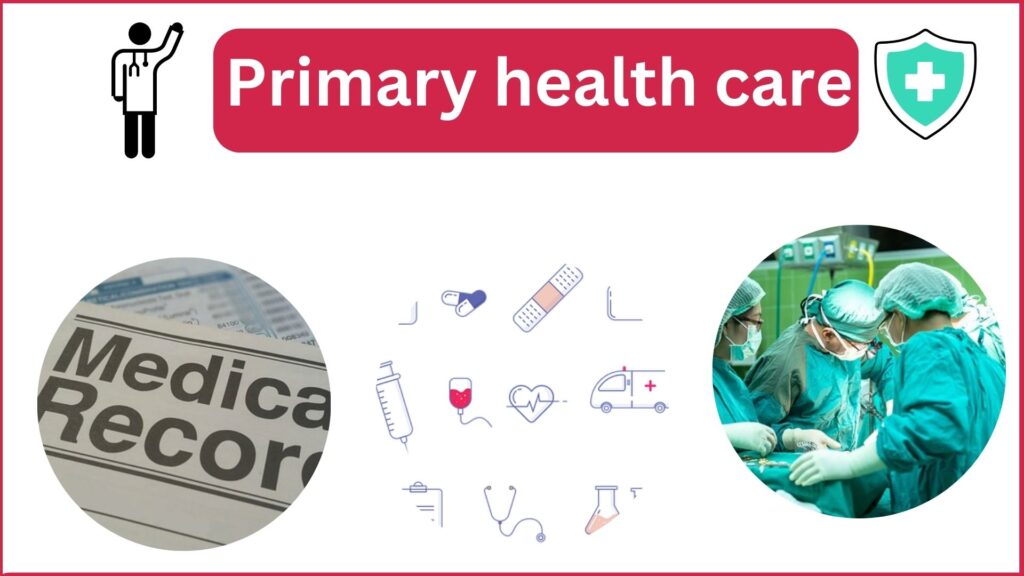Primary health care : Definition, Components & principles
Primary Health Care
We have described in article :
Definition of Primary Health Care
Components of Primary Health Care
Background of Primary Health Care
Principles of Primary Health Care

Definition of Primary health care :
Primary health care (PHC) : The concept of primary health care came into limelight in 1978 following an international conference in Alma-Ata (former USSR). It has been defined as
“Essential health care based on practical, scientifically sound and socially acceptable methods and technology made universally accessible to individuals and families in the community through their full participation and at a cost that the community and the country can afford to maintain at every stage of their development in the spirit of self-determination”.
Components/elements of Primary health care (PHC) :
The declaration of Alma-Ata stated that PHC includes at least :
- Education about prevailing health problems and methods of preventing & controlling them.
- Promotion of food supply & proper nutrition.
- An adequate supply of sale water and basic sanitation.
- Maternal & child health care, including family planning.
- Immunization against infectious diseases.
- Prevention & control of locally endemic diseases.
- Appropriate treatment of common diseases & injuries.
- Provision of essential drugs.
Easy to Remember: Elements of Primary health care (PHC) –
- E = Education about health problems and their control.
- L= Local disease control.
- E= EPI (Expanded Program on immunization).
- M = Maternal and child health care including family planning.
- E = Essential drugs provision.
- N = Promotion of food supply and proper nutrition.
- T = Treatment of common diseases and injuries.
- S = An adequate supply of safe water and basic sanitation.
Background of primary health care :
The concept of primary health care came into limelight in 1978 following an intentional conference in Alma-Ata (former USSR). It is accepted by the member countries of WHO as the key to achieving the goal of health for all by the year 2000 AD.
Before Alma Ata. primary health care was regarded as synonymous with “basic health service”, “first contact cure”, “easily accessible care”. “services provided by generalists” etc. it was the Alma Ata conference that broadened the earlier restrictive concept and provided it a political dimension and declared the strategy f achieving the goal of HFA by 2000 AD through the key approach of primary health care.
Principles of primary health care :
- Equitable distribution of health services.
- Community participation at all level.
- Inter-sectoral co-ordination/Multi-sectoral approach.
- Appropriate technology.
Explanation of the principles health care :
Equitable distribution : Health services must be shared equally by all people irrespective of their ability to pay. Rich or poor urban or rural must have access to health services, e.g PHC services should be given according to priority of needs i.e. the needy and vulnerable groups of population in rural areas and urban slums.
Community participation : It is defined as the process by which individuals and families assume responsibility for their own health and welfare and for those of the community and develop the capacity to contribute to their and the community’s development.
- Involvement of individuals, families, communities, in promotion of their own health and welfare is an essential ingredient of PHC.
- Community involvement also implies that the community should participate in the planning implementation and maintenance of health services.
- Example : To make the EPI successful in the whole world, community participation has a great role.
- Importance:
- It leads to sense of responsibility for the project.
- More will be accomplished.
- Participation guarantees that a felt need is involved
- Services can be provided at a lower rate.
- Participation has an intrinsic value for the participants.
- It is a catalyst for further development effort.
Multisectoral approach/Intersectoral coordination:
The component of PHC cannot be provided by the health sector alone. PHC involves in addition to health sector all health related sector. i.e.
- Agriculture
- Animal husbandry
- Food
- Industry Education
- Housing Public health engineering
- Social welfare :
- An important element of intersectoral approach is planning with other sectors to avoid unnecessary duplication of activities.
- Example : To provide adequate supply of safe water and basic sanitation of a community, the coordinated approach of Health department, Public health engineering department and information department are needed.
Appropriate technology :
- It is scientifically sound.
- Adaptable to local needs.
- Acceptable to those who apply it, and are used.
- It can be maintained with the community resources.
Example : Hand-made ORS for diarrhoeal diseases, bifurcated needle for vaccination.
Constrains of healthcare delivery at primary level :
- Persistent bias towards curative aspect shown by the people as well as health personnel.
- Lack of adequately trained and motivated manpower.
- Absence of appropriately managed referral system.
- Difficulty in involving the people.

This web site is really a walk-through for all of the info you wanted about this and didn’t know who to ask. Glimpse here, and you’ll definitely discover it.